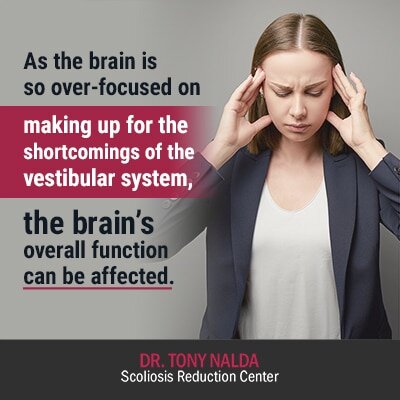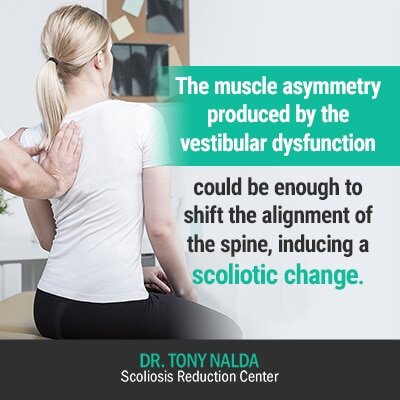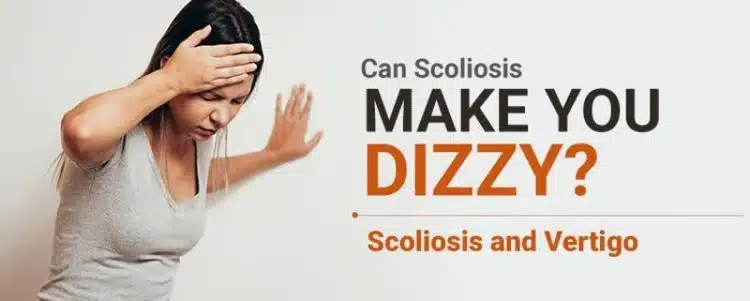While every scoliosis patient will have their own unique experience of their condition, there are some common symptoms. In the context of scoliosis and vertigo, it’s interesting that people with vertigo describe it as a feeling of being off-balance and pulled to one side; this is also a common description of how it feels to live with scoliosis. Keep reading to explore the nature of the connection between the two.
The vestibular system includes parts of the inner ear and brain, and this system controls balance and eye movements. While several studies show an association between scoliosis and vestibular abnormality, which would produce vertigo, it appears that the nature of that association is more correlative than causative.
Although there are many different forms of scoliosis, for our current purposes, we will focus on the condition’s most common form: adolescent idiopathic scoliosis (AIS). Before we move on to the connection between scoliosis and vertigo, let’s first make sure we fully understand the nature of vertigo.
What is Vertigo?
Many people assume ‘vertigo’ is the name of a condition, but it is, instead, a symptom of vestibular dysfunction.
This happens often where symptoms can become known as the condition that causes them, but this leads to a potentially-dangerous misconception.
Treating a condition means addressing its underlying cause, the root cause. A symptom is how the body is responding to said condition, and this is an important distinction because solely addressing a condition’s symptom is like putting a Bandaid on it, rather than treating the actual cause of the symptom, which is the condition itself.
The vestibular system refers to parts of the inner ear that are involved in balance. It has a bony labyrinthine quality and is made up of the vestibule, semicircular canals, and the membranes contained within these structures.
Someone experiencing vertigo would likely explain it as a spinning sensation and feeling like they, or their surroundings, are moving, when they are not.
Vertigo can strike while still, moving, or in specific positions, and it is often accompanied by feelings of lightheadedness, floating, or general dizziness.
The vestibular system also includes parts of the brain, and in addition to balance, the system facilitates proprioception (body-position awareness without visual cues), and eye movement.
If the vestibular system is damaged or impaired in some way, a vestibular disorder can develop and produce a number of symptoms.
Symptoms of Vestibular System Abnormality
There are numerous symptoms associated with vestibular system aberrations, and depending on the nature of the abnormality, they can range significantly in both frequency and severity:
Dizziness – the sensation of faintness, lightheadedness, and feeling unsteady.
Vertigo – a feeling of spinning even when still. People experiencing vertigo often perceive they, or items around them, are moving.
Imbalance – feeling unsteady, disoriented in space, and a loss of equilibrium.
Brain fog – with vestibular abnormalities, often the brain has to work extra hard to maintain balance and equilibrium.

As the brain is so over-focused on making up for the shortcomings of the vestibular system, the brain’s overall function can be affected.
Most often, this includes difficulty remembering details and retrieving short-term memories.
People often describe this ‘brain fog’ as feeling medicated and sluggish.
Tinnitus – perceiving an abnormal noise in one or both ears, or in the head.
Tinnitus can come and go, or be continuous. While the type of perceived sound varies from one person to the next, it’s commonly described as either a ringing, whistling, hissing, clicking, or buzzing sound.
The sound can vary in pitch from a low hum to a high-pitched squeal.
Loss of hearing – hearing impairment is a common symptom of numerous vestibular disorders, and hearing loss can affect one or both ears.
Loss of vision – as the vestibulo-ocular reflex (VOR) links vision to the vestibular system, loss of vision can occur when vestibular issues are present.
Nausea – the unpredictable sensation of movement can lead to nausea.
Motion sickness – when the central nervous system (brain and spinal cord) get confusing messages from the visual system and the vestibular system in the inner ears, motion sickness can occur.
The aforementioned symptoms can range in severity and be hard to describe, which can complicate the diagnostic process for vestibular disorders.
Now that we have taken a general look at the vestibular system and some of the symptoms an abnormality can produce, let’s connect that to scoliosis.
Scoliosis
Scoliosis is a condition characterized by an abnormal sideways curvature of the spine, that also rotates, and has a Cobb angle of more than 10 degrees.
Cobb angle is a measurement of how far out of alignment a curvature is, and this places the condition on its severity scale of mild, moderate, and severe.
The higher the Cobb angle, the more severe the condition is considered.
Generally speaking, the more severe a condition is, the more likely it is to produce noticeable symptoms such as postural changes.
When it comes to the postural changes associated with scoliosis, they are commonly attributed to an overall asymmetry of the body.
As the spine is curved abnormally to the side, this can make the shoulders uneven with one sitting higher than the other.
It can make the arms and legs appear to be hanging at different lengths. The head can seem uncentered over the torso, and the torso can seem uncentered over the waistline.
A rib arch is commonly associated with curvatures of the thoracic spine (middle back), and this can look like one side of the rib cage is protruding more than the other.
Sometimes, adolescents notice their clothes don’t seem to be fitting properly. Sleeves and pant-legs can hang unevenly, shirt necklines can seem off-center, and it can seem as though clothes don’t fit the same way they used to.
Additional symptoms include issues with balance, equilibrium, and proprioception: also common symptoms produced by aberrations of the vestibular system.
When considering these symptoms, it’s interesting that people with vertigo and people with scoliosis, sometimes describe their conditions as feeling weighed down and/or pulled more in one direction.
But that is the connection between the two? Is it correlative, meaning there’s a suspected relationship between the two, or is it causative, meaning one condition contributes to the etiology of the other?
Scoliosis and Vertigo
As mentioned, AIS is the most common form of scoliosis and is diagnosed between the ages of 10 and 18; in fact, AIS accounts for 80 percent of diagnosed scoliosis cases.
As the cause of AIS is unknown and the condition has such a high prevalence, a lot of studies and research have been devoted to understanding its causation.
Keep in mind that AIS has no ‘single’ known cause, and is, instead, considered to be multifactorial, meaning its onset could be the result of a combination of variables that can change from person to person.
With conditions considered to be multifactorial, it can be very challenging to try and gain a clear understanding of their etiology (causes, or causes, of their development).
Efforts to understand etiology are important; a clearer understanding of a condition’s underlying cause can potentially lead to prevention and helps direct treatment.
So why is it that we so often see scoliosis coupled with vertigo in patients?
What the Research Tells Us
While initial explorations of scoliosis etiology have focused on genetic, biomechanical, biochemical, congenital, and nutritional causes, that focus has shifted over the years to include vestibular imbalance.
Again, while some studies show that scoliosis and vertigo have a connection, due to the multifactorial nature of AIS, these findings indicate that the vestibular system might play a ‘role’ in scoliosis etiology, but it cannot be determined as its single root cause.
There was a 2006 study that looked at the prevalence of people with scoliosis, osteoporosis, and vertigo and why these three conditions so often appear together.
While some studies consider scoliosis development as the result of muscle imbalance, this study suggested scoliosis is a problem with normal-bone formation.
The study showed a correlation between osteopenia (low bone density) and scoliosis progression as the lower a participant’s bone-quality, the worse their scoliosis became.
What was even more interesting and gave more support to the theory was that researchers found osteopenia also in adolescent study participants.
As low bone density is an issue related to older individuals, especially peri-menopausal women, the presence of low bone density in adolescents wasn’t necessarily because their bones were losing minerals, but because their bones were never able to mineralize properly.
The study then moved on to explore why scoliosis and vertigo are so often coupled clinically.
The study presents the most common vestibular disorder as related to calcium carbonate crystals that come loose in the middle ear and irritate the position-sensitive hair cells located within.
Again, the composition of bone is playing a role, as bone density appeared to play a role in the prevalence of people presenting with both scoliosis and osteoarthritis.
As it has been reported that there is a high prevalence of people with osteoporosis, vertigo, and scoliosis, the study sought to find that unifying theory.
The study lasted five years and found that vertigo had a lot to do with bone health and composition, and we know what a big factor that is in both osteoporosis and scoliosis.
It looked at 132 patients suffering from vertigo and conducted bone mineral density testing. Blood samples were taken to look for bone-turnover markers like calcitonin and alkaline phosphatase.
Calcium and vitamin D levels were measured, and vitamin D deficiency turned out to be a big marker for vertigo, osteoporosis, and scoliosis.
The unifying theory presented by this study suggested that vertigo, osteoporosis, and scoliosis are conditions of bone remodeling.
More Study Results
Another study explored the long-suspected link between AIS and vestibular-organ dysfunction.
It looked at how the vestibular system can affect perceived verticality, head position, and other functions related to balance. When this happens, a neurogenic truck shift or a torsional effect can be felt by the spine as certain muscle groups are activated asymmetrically.

The study discussed how the muscle asymmetry produced by the vestibular dysfunction could be enough to shift the alignment of the spine, inducing a scoliotic change.
What this means is if the vestibular asymmetry does indeed lead to an asymmetrical engagement of the paraspinous musculature (muscles supporting the back), this could be a potential factor in the etiology of AIS.
The study also addressed the anatomical correlates between vestibular activity and functional deficits seen in scoliosis patients.
After assessing the MRIs of 90 patients with lumbar scoliosis, the results showed that the thickness of the brain’s cerebral cortex in areas engaged in vestibular function was altered in AIS patients.
Also via MRI, measurements of the canals that make up the labyrinthine structure of the inner ear were found to be altered in participants with scoliosis, and that there was an abnormal direct relationship between the lateral and posterior vestibular canal in 55 percent of scoliosis subjects.
So what exactly does all this mean? Currently, there is a lot of literature containing evidence of a link between scoliosis and vestibular abnormality; however, it remains a ‘link’ as more studies need to be done in assessing causality.
With advancements made in vestibular testing since the completion of these studies, perhaps clearer answers are more within reach.
Now that we understand some of the possible connections between the vestibular system, vertigo, and scoliosis, let’s move on to discussing how scoliosis makes you dizzy.
Can Scoliosis Cause Dizziness?
So to clearly answer the question, can scoliosis make you dizzy: yes, it can. Scoliosis can do this in a number of ways, although it’s also important to remember that having scoliosis does not automatically mean a person will experience dizziness as a related symptom.
If you think back to the postural changes that are common symptoms of AIS, these are the result of the body being exposed to uneven forces.
Now, as one of the roles of the spine is to help us maintain a straight and upright posture for optimal movement, balance and equilibrium, you can imagine how a condition that causes asymmetrical changes to the body can make a person feel unbalanced and dizzy.
In addition, another common symptom of scoliosis are headaches and/or migraines. This is particularly the case with curvatures of the cervical spine (neck) as adverse muscle strain and forward head posture can lead to debilitating tension headaches.
Scoliosis can also disrupt the body’s course of cerebrospinal fluid (CSF) as it flows through the spinal canal and fills spaces in and around the brain.
CSF helps to protect the brain and spinal cord by cushioning it, and it also helps eliminate waste from the brain and transport vitamins and nutrients.
When the spine has an abnormal curvature, the structural change can disrupt that flow, and when CSF pressure drops in the brain, debilitating headaches and/or migraines can occur.
Anyone who has suffered from chronic headaches or had a migraine will recall the dizziness and lightheadedness that can accompany them.
We also know that the brain and spinal cord work together to form the central nervous system: the body’s communication network. Although the main structures of the vestibular system are in the inner ear, it does also include parts of the brain, so scoliosis does also have the potential to affect the brain and its function within the vestibular system.
To return to the studies mentioned earlier, the links found between the vestibular system, vertigo, and scoliosis, revealed how bone composition issues and/or anatomical differences in the inner ear of scoliosis patients can produce feelings of dizziness.
What we can also see is that scoliosis exposes the body to a lot of uneven forces, and those uneven forces produce asymmetrical changes within the body.
Depending on the severity of the condition, these changes can range from mild to moderate and severe and can produce additional symptoms such as vertigo and feelings of dizziness.
While we cannot definitively say that AIS is caused by vestibular system abnormality, we can say that there is significant supporting evidence for connections between the two, and vertigo/dizziness can be a scoliosis-related symptom.
Conclusion
Scoliosis is a complex condition that can range greatly in severity and in the symptoms it produces.
While each patient will have their own unique scoliosis experience, there are some common symptoms, and one is vertigo and/or dizziness.
While the one study did suggest that vestibular organ dysfunction could affect verticality perception, causing a neurogenic effect that alters the symmetry of the paraspinous musculature, could this change, or how it interacts with another variable, be enough to cause scoliosis to develop?
If that is the case, this is leaning towards a causative connection, but there hasn’t been enough supporting evidence, and study results haven’t been reproduced consistently enough to support a purely causative connection over one that is more correlative.
In addition, other studies find different potential causative connections for scoliosis such as bone-remodeling issues.
It is interesting how certain conditions tend to present together, and the common appearance of scoliosis, osteoporosis, and vertigo in patients does suggest that the source of that connection could be a contributing factor in the multifactorial causation of adolescent idiopathic scoliosis.
Ultimately, it appears that adolescent idiopathic scoliosis is a multifactorial condition spectrum with multiple etiologies, one of which could be vestibular-system related.
Here at the Scoliosis Reduction Center® patients suffering from vertigo and/or dizziness report vast improvements once the effects of a curvature reduction are felt throughout the body.





